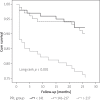Platelet/lymphocyte ratio was associated with impaired myocardial perfusion and both in-hospital and long-term adverse outcome in patients with ST-segment elevation acute myocardial infarction undergoing primary coronary intervention
- PMID: 26677378
- PMCID: PMC4679796
- DOI: 10.5114/pwki.2015.55599
Platelet/lymphocyte ratio was associated with impaired myocardial perfusion and both in-hospital and long-term adverse outcome in patients with ST-segment elevation acute myocardial infarction undergoing primary coronary intervention
Abstract
Introduction: Platelet/lymphocyte ratio (PLR) has been shown to be an inflammatory and thrombotic biomarker for coronary heart disease, but its prognostic value in ST-segment elevation myocardial infarction (STEMI) has not been fully investigated.
Aim: To investigate the relationship between PLR and no-reflow, along with the in-hospital and long-term outcomes in patients with STEMI.
Material and methods: In the present study, we included 304 consecutive patients suffering from STEMI who underwent primary percutaneous coronary intervention (p-PCI). Patients were stratified according to PLR tertiles based on the blood samples obtained in the emergency room upon admission. No-reflow after p-PCI was defined as a coronary thrombolysis in myocardial infarction (TIMI) flow grade ≤ 2 after vessel recanalization, or TIMI flow grade 3 together with a final myocardial blush grade (MBG) < 2.
Results: The mean follow-up period was 24 months (range: 22-26 months). The number of patients characterized with no-reflow was counted to depict increments throughout successive PLR tertiles (14% vs. 20% vs. 45%, p < 0.001). In-hospital major adverse cardiovascular events and death increased as the PLR increased (p < 0.001, p < 0.001). Long-term MACE and death also increased as the PLR increased (p < 0.001, p < 0.001). Multivariable logistic regression analysis revealed that PLR remained an independent predictor for both in-hospital (OR = 1.01, 95% CI: 1.00-1.01; p = 0.002) and major long-term (OR = 1.01, 95% CI: 1.00-1.01; p < 0.001) adverse cardiac events.
Conclusions: Platelet/lymphocyte ratio on admission is a strong and independent predictor of both the no-reflow phenomenon and long-term prognosis following p-PCI in patients with STEMI.
Keywords: ST-segment elevation acute myocardial infarction; in-hospital mortality; long-term mortality; no-reflow; platelet/lymphocyte ratio.
Figures
References
-
- Brosh D, Assali AR, Mager A, et al. Effect of no-reflow during primary percutaneous coronary intervention for acute myocardial infarction on six-month mortality. Am J Cardiol. 2007;99:442–5. - PubMed
-
- Bolognese L, Carrabba N, Parodi G, et al. Impact of microvascular dysfunction on left ventricular remodeling and long-term clinical outcome after primary coronary angioplasty for acute myocardial infarction. Circulation. 2004;109:1121–6. - PubMed
-
- Rezkalla SH, Kloner RA. No-reflow phenomenon. Circulation. 2002;105:656–62. - PubMed
-
- Tanboga IH, Topcu S, Aksakal E, et al. Determinants of angiographic thrombus burden in patients with ST-segment elevation myocardial infarction. Clin Appl Thromb Hemost. 2014;20:716–22. - PubMed
-
- Gürsoy OM, Karakoyun S, KalçIk M, et al. Usefulness of novel hematologic inflammatory parameters to predict prosthetic mitral valve. Am J Cardiol. 2014;113:860–4. - PubMed
LinkOut - more resources
Full Text Sources
Other Literature Sources
Miscellaneous


